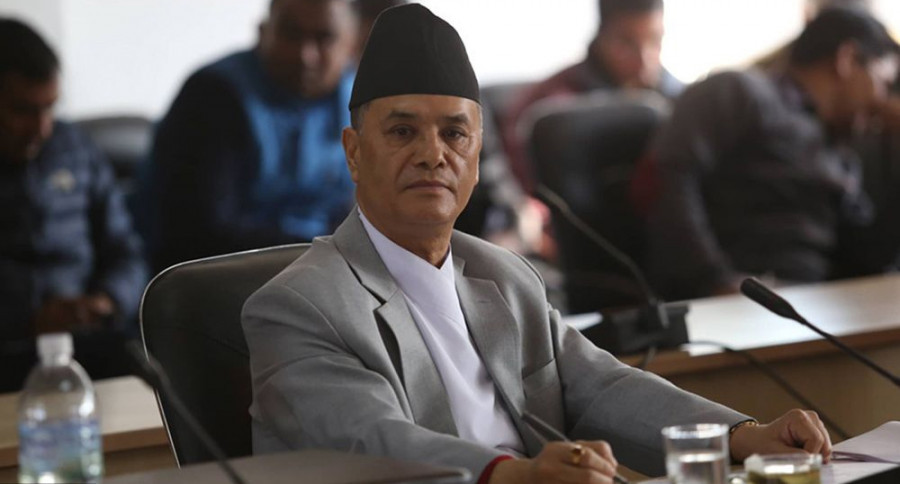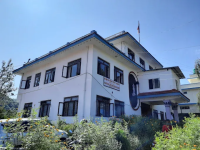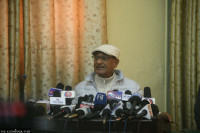National
All eyes on Chief Justice Rana, as crisis deepens in the judiciary
After Rana constituted the bench on seniority basis, Oli’s lawyers demand expulsion of two justices for their position that current House dissolution is linked to March 7 verdict.
Tika R Pradhan
Nepal’s judiciary is facing a tough time extricating itself from an ongoing crisis it has plunged into after questions raised over justices and their presence in the Constitutional Bench which is hearing petitions on the May 21 House dissolution.
After senior advocates pleading on behalf of the petitioners asked not to have at least two justices on the bench, Chief Justice Cholendra Shumsher Rana on Sunday reconstituted it by designating justices on the basis of their seniority.
But those defending Prime Minister KP Sharma Oli’s House dissolution decision, including Attorney General Ramesh Badal, demanded that at least two justices cannot be on the bench because of the position they have taken that does not appear impartial.
Now pressure is building on Chief Justice Rana to resolve the crisis and find an amicable solution as the judiciary’s independence is at stake.
“The chief justice must be assertive and show his leadership now,” said Balaram KC, a former Supreme Court justice. “The longer the crisis continues, the more harm the Supreme Court will suffer.”
Chief Justice Rana initially on May 28 had formed the Constitutional Bench with Justices Deepak Kumar Karki, Ananda Mohan Bhattarai, Tej Bahadur KC and Bam Kumar Shrestha as members.
However, those arguing on behalf of the petitioners said that Justices Tej Bahadur KC and Bam Kumar Shrestha cannot be on the bench.
They argued that Shrestha was one of the justices of the bench that on March 7 passed a verdict which invalidated the Nepal Communist Party (NCP) and revived the CPN-UML and the Communist Party of Nepal (Maoist Centre). They had said that the current House dissolution was a direct outcome of that decision.
Though Chief Justice Rana had tried to defend, saying everyone must have faith in justices, the lawyers refused to listen. The lawyers also questioned KC’s presence on the bench, saying he was one of the justices of the bench, led by Rana, that rejected Maoist chair Pushpa Kamal Dahal’s petition against the March 7 decision.
Though it would have been natural for both KC and Shrestha to recuse themselves after questions were raised against them, they refused to do so.
Instead, Justice Deepak Kumar Karki and Ananda Mohan Bhattarai decided to opt out of the bench.
To prevent an imminent crisis in the judiciary, the Supreme Court Bar Association intervened and held discussions with Chief Justice Rana on June 1. The Supreme Court Bar advised Rana to reconstitute the bench on the basis of seniority.
The constitution envisions a Constitutional Bench led by the chief justice with four other members.
Article 137 (1) says the Constitutional Bench consists of the chief justice and
other four judges designated by the chief justice on the recommendation of the
Judicial Council.
The Supreme Court (Constitutional Bench Operation) Regulations 2072 BS also do not say anything about seniority of justices for the institution of such a bench.
A proposal to amend the Regulations so as to appoint justices on the bench on the basis of their seniority was taken to the full court on Friday. But the full court refused to amend the Regulations, saying they did not create any hurdle for the chief justice to pick justices on the basis of seniority.
As had been agreed upon, Rana on Sunday designated Justices Deepak Kumar Karki, Mira Khadka, Ishwar Khatiwada and Ananda Mohan Bhattarai to the bench, based on their seniority.
After the hearing started, Attorney General Badal alleged that the composition of the bench was lopsided and that it favoured the petitioners.
He was hinting at Karki and Bhattarai who on June 1 had in their opinion written that they would like to opt out of the earlier bench, as the March 7 decision and the current House dissolution were related.
Karki and Bhattarai, however, had to be chosen for the new bench on Sunday because of their seniority.
Badal argued before the bench that the two justices should leave the bench. Former attorney general Agni Kharel and senior advocate Sushil Panta too made similar arguments.
Questions are now being asked if lawyers representing the plaintiffs and defendants continue to question the justices and the composition of the bench, it will not only delay the hearing but also raise a huge moral question for the judiciary itself.
Until the fresh crisis emerged, Rana had been forming the bench by picking judges from a roster of 14 justices.
According to KC, the former Supreme Court justice, the seeds of the crisis were sown some six years ago when the leadership of the judiciary incorporated the issue of Constitutional Bench in the constitution and subsequently the Judicial Council took a decision of setting up a roster of justices for the Constitutional Bench.
Questions as to why Chief Justice Rana did not form the Constitutional Bench with justices based on their seniority were asked when Oli’s earlier decision on December 20 to dissolve the House was challenged in the court.
But lawyers soon turned their focus towards Justice Hari Krishna Karki, demanding that his presence on the bench constituted a conflict of interest. Karki in 2016, during Oli’s first stint as prime minister, had served as the attorney general. After Karki recused himself from the hearing, Justice Sapana Pradhan Malla replaced him.
After the Constitutional Bench overturned Oli’s decision and restored the House, the issue of seniority was forgotten, as many believed the end justifies the means.
But not many were expecting the issue to raise its ugly head again, and this time the judicial process has been completely bogged down by arguments and counterarguments of the bench and its formation.
On Friday, advocate Rajaram Ghimire presented a petition, demanding that 11 senior justices have a conflict of interest in House dissolution cases, therefore they must not be included on the Constitutional Bench.
Ghimire, who has filed petition demanding that Oli be appointed prime minister under Article 76 (5), has named Deepak Kumar Karki, Mira Khadka, Hari Krishna Karki, Bishowambhar Shrestha, Ishwar Khatiwada, Ananda Mohan Bhattarai, Anil Sinha, Prakash Man Singh Raut, Sapana Pradhan Malla, Tej Bahadur KC and Bam Kumar Shrestha as those whose presence on the bench would amount to a conflict of interest.
Only Tanka Bahadur Moktan will remain in the 13-justice roster if the 11 justices are not included on the bench. But the court refused to register the petition.
Lawyers arguing against the House dissolution said that the way the executive is acting, deploying its lawyers to file petitions against about a dozen justices, shows its sinister attitude.
“If the executive tries to damage the image of the judiciary, something which was not attempted by the Panchayat and king’s regimes, the judiciary must not remain a mere spectator,” said advocate Tikaram Bhattarai during Sunday’s hearing.
Senior advocate Raman Kumar Shrestha also said that the judiciary was not under attack like it is today even during the king’s direct rule.
“That a petition has been brought arguing that 11 justices cannot be included on the Constitutional Bench is worrying,” said Shrestha during the hearing. “The government is bent on assaulting the judiciary.”
A Supreme Court justice told the Post that the situation has become “very complicated”.
“A decision on how to deal with the issue may come on Monday,” said the justice who spoke on condition of anonymity.
That the ongoing arguments and counterarguments are creating unease among justices was evident from a justice’s remark during Sunday’s hearing.
“We are not feeling comfortable with whatever has been going on,” said Justice Khatiwada asking government’s lawyers to allow those arguing for petitioners to put forth their views. “We have had enough questions over the bench. This should not happen.”
A senior advocate said the chief justice is to blame for creating the crisis, as he decided to pick juniors like Bam Kumar Shrestha and Tej Bahadur KC for the Constitutional Bench. KC and Shrestha rank 11th and 12th on the roster from where the chief justice had picked justices for the bench initially.
“The Chief justice has opened Pandora's box,” Shree Prasad Pandit, a senior advocate who served as the registrar of the Supreme Court in the past, told the Post.
“We are left with no option but to watch the ongoing drama,” said Pandit. “If the issue continues to escalate, the Supreme Court Bar Association should take an initiative to defuse the crisis.”




 12.12°C Kathmandu
12.12°C Kathmandu













%20(1).jpg&w=300&height=200)

